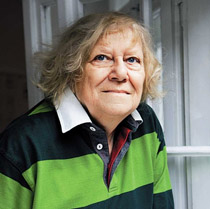
Alena Šrámková will celebrate her eightieth birthday on Saturday
 |
The list of her works is extensive and the character of the designs is very diverse. Typologically, it can be said that it ranges from a chemical plant to a hotel interior, locally from Wenceslas Square through an empty hill above Cheb (meteorological station) to an almost forest solitude. However, her handwriting always remains legible. Šrámková asserts that a house has obligations towards humanity in general – it must not scare, shock, or blind people; it must be honest, strong enough to influence them.
The architect is among the representatives of the so-called Czech austerity, as architecture historian Rostislav Švácha characterized a group of creators characterized by a tendency towards minimalist trends.
The ČKD headquarters on Wenceslas Square (1983), which Šrámková designed together with her husband Jan, responded to the then-current developments in foreign architecture. In the stagnant normalization space, the building then became a kind of symbol of thaw. Postmodern "appearance" with large clocks slightly inserted into the center, however, sparked discussions long after its completion. The ČKD building served until the end of the 1990s, after which Šrámková was also involved in the renovation of the protected structure.
Among her other works (realized or projects) besides the Prague train hall (1977), which she designed with three colleagues, are the cultural center Lužiny (with Ladislav Lábus), a small tower for a scientific worker in Košík, the Šerák meteorological station, Hypobanka in náměstí Republiky, a footbridge in Holešovice, a home with caretaking services in Horažďovice, the new Tyrš Bridge in Přerov, a malt house in Olomouc, or the building of the Faculty of Architecture at Czech Technical University in Dejvice.
Šrámková was born on June 20, 1929, in Prague. She studied at the Technical University in Bratislava and the Academy of Fine Arts in Prague in Jaroslav Fragner's studio. She then passed through several design offices, and by the end of the 1980s, she worked in the SIAL studio, which under the leadership of Karel Hubáček represented one of the few distinctive and original currents of Czech architecture since the 1960s.
In 1992, Šrámková founded her own studio (Šrámková architects), where she now works with two colleagues. In recent years, the studio has participated in numerous competitions, often winning or receiving awards, though some of its buildings, unfortunately, remained only on paper. Šrámková has never felt the need to measure herself against the trend that is currently "in style."
A certain "inaccessibility" or radical nature of her thinking is attractive even to her younger colleagues, to whom she has been academically dedicated at the Czech Technical University in Prague since 1991 (she has been a professor since 1999). Šrámková was the first chairwoman of the Architects' Association after 1989; the organization awarded her the Prize for Personality in Czech Architecture in 1994. Last year, she received the Medal of Merit and the Honorary Award from the Czech Chamber of Architects for her contribution to modern Czech architecture in 2007.
The English translation is powered by AI tool. Switch to Czech to view the original text source.
3 comments
add comment
Subject
Author
Date
Jak naše mudrosloví praví: "Betr lejt tzen nevr"
Dr. Lusciniol
22.06.09 01:03
...No, kde by?...
šakal
22.06.09 01:23
Děkuji "šakale"
Dr. Lusciniol
23.06.09 11:32
show all comments






